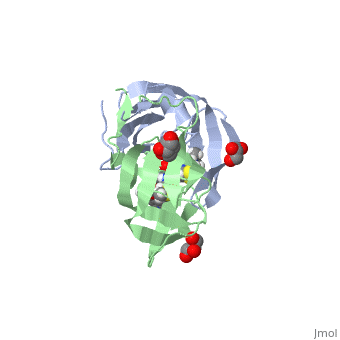Integrase: Difference between revisions
Michal Harel (talk | contribs) No edit summary |
Michal Harel (talk | contribs) No edit summary |
||
| (4 intermediate revisions by the same user not shown) | |||
| Line 144: | Line 144: | ||
***1.45 A resolution | ***1.45 A resolution | ||
***[http://www.ebi.ac.uk/pdbe/entry/search/index?organism_scientific_name:%22Homo%20sapiens%22&all_molecule_names:%22Integrase%22&!chimera:y Search for other PDB entries] | ***[http://www.ebi.ac.uk/pdbe/entry/search/index?organism_scientific_name:%22Homo%20sapiens%22&all_molecule_names:%22Integrase%22&!chimera:y Search for other PDB entries] | ||
</StructureSection> | |||
==3D structures of integrase see [[Retroviral Integrase]]== | |||
[[Category:Topic Page]][[Category:PDBe]] | [[Category:Topic Page]][[Category:PDBe]] | ||
Latest revision as of 13:50, 4 September 2018
Best example is PDB entry 3fx5 and is shown in the viewer. Molecule Integrase, also known as Integrase, p2B, p10, Capsid protein p27, p4, p3, Reverse transcriptase beta-subunit, Protease p15, Nucleocapsid protein p12, Reverse transcriptase alpha-subunit, RT-alpha, p2A, RT-beta, Gag-Pro-Pol polyprotein, pp32, Matrix protein p19, IN, Matrix protein p17, Transframe peptide, Reverse transcriptase/ribonuclease H, Pr160Gag-Pol, Spacer peptide 1, p2, Exoribonuclease H, p6*, Gag-Pol polyprotein, Nucleocapsid protein p7, p15, Retropepsin, p6-pol, p66 RT, Protease, PR, CA, TF, NC, SP1, Capsid protein p24, MA, p51 RT, Ribonuclease H, Protease/Reverse transcriptase, Pro-Pol polyprotein, Pr125Pol, Protease/Reverse transcriptase/ribonuclease H, RNase H, p87Pro-RT-RNaseH, p42In, p65Pro-RT, INT, Pol polyprotein, dUTPase, RT, Deoxyuridine 5'-triphosphate nucleotidohydrolase, P72, Pr170Gag-Pol, p11, p2L, Capsid protein p26, Matrix protein p16, P119, Putative prophage integrase, Int protein, CP4-like integrase, Transposase from transposon Tn916, NC-pro, Pr160Gag-Pro-Pol, Nucleocapsid protein p15-pro, p1 and NC'. FunctionIntegrase: Catalyzes viral DNA integration into the host chromosome, by performing a series of DNA cutting and joining reactions. This enzyme activity takes place after virion entry into a cell and reverse transcription of the RNA genome in dsDNA. The first step in the integration process is 3' processing. This step requires a complex comprising the viral genome, matrix protein, Vpr and integrase. This complex is called the pre-integration complex (PIC). The integrase protein removes 2 nucleotides from each 3' end of the viral DNA, leaving recessed CA OH's at the 3' ends. In the second step, the PIC enters cell nucleus. This process is mediated through integrase and Vpr proteins, and allows the virus to infect a non dividing cell. This ability to enter the nucleus is specific of lentiviruses, other retroviruses cannot and rely on cell division to access cell chromosomes. In the third step, termed strand transfer, the integrase protein joins the previously processed 3' ends to the 5' ends of strands of target cellular DNA at the site of integration. The 5'-ends are produced by integrase-catalyzed staggered cuts, 5 bp apart. A Y-shaped, gapped, recombination intermediate results, with the 5'-ends of the viral DNA strands and the 3' ends of target DNA strands remaining unjoined, flanking a gap of 5 bp. The last step is viral DNA integration into host chromosome. This involves host DNA repair synthesis in which the 5 bp gaps between the unjoined strands are filled in and then ligated. Since this process occurs at both cuts flanking the HIV genome, a 5 bp duplication of host DNA is produced at the ends of HIV-1 integration. Alternatively, Integrase may catalyze the excision of viral DNA just after strand transfer, this is termed disintegration.Data source: Uniprot P03367 Catalytic ActivityDeoxynucleoside triphosphate + DNA(n) = diphosphate + DNA(n+1).Data source: Uniprot P03367 DiseaseRelevanceStructural highlightsBiological processIs involved in the following biological processes: proteolysis In structuresIntegrase is found in 1103 PDB entries
|
| ||||||||||
